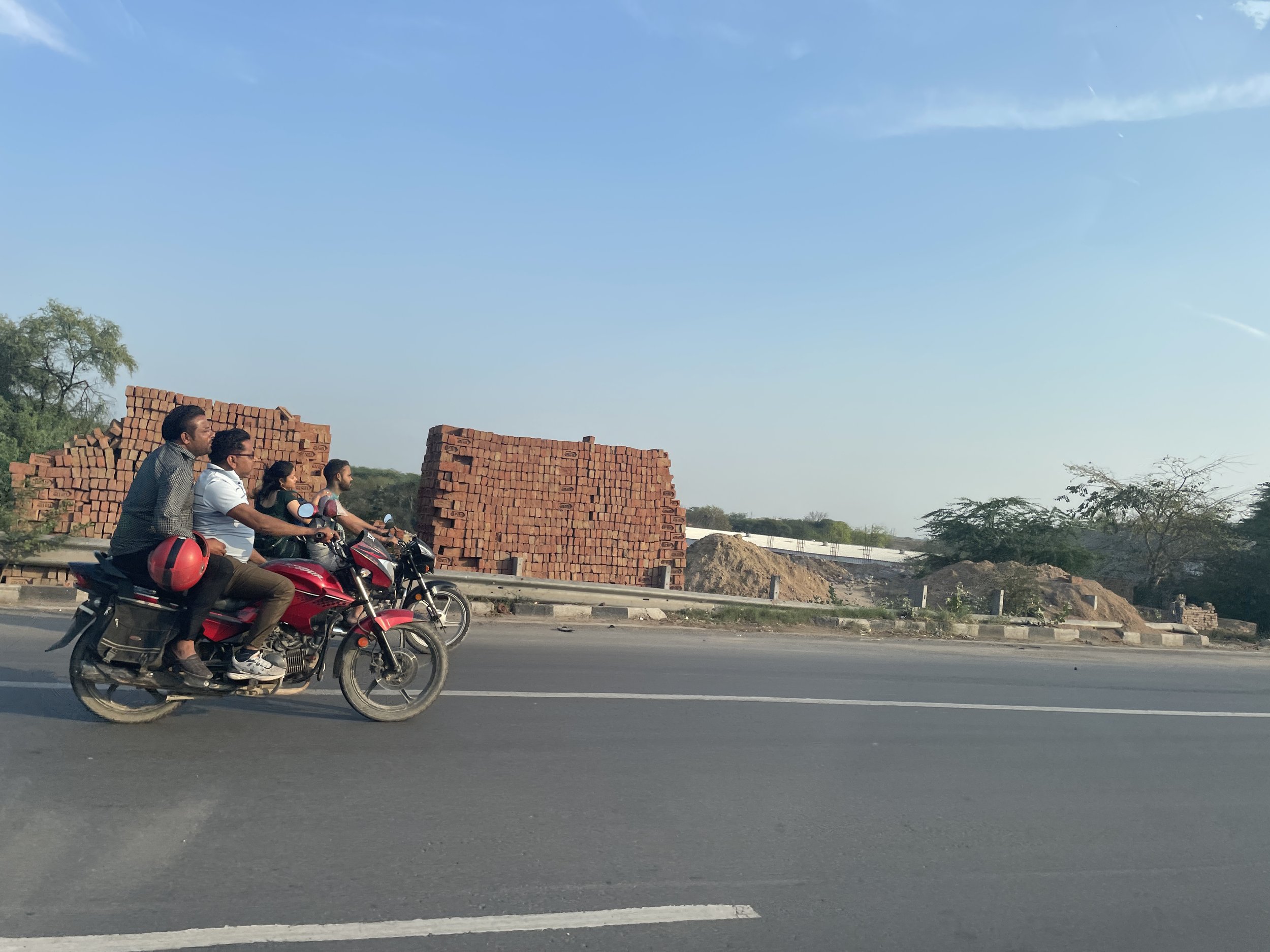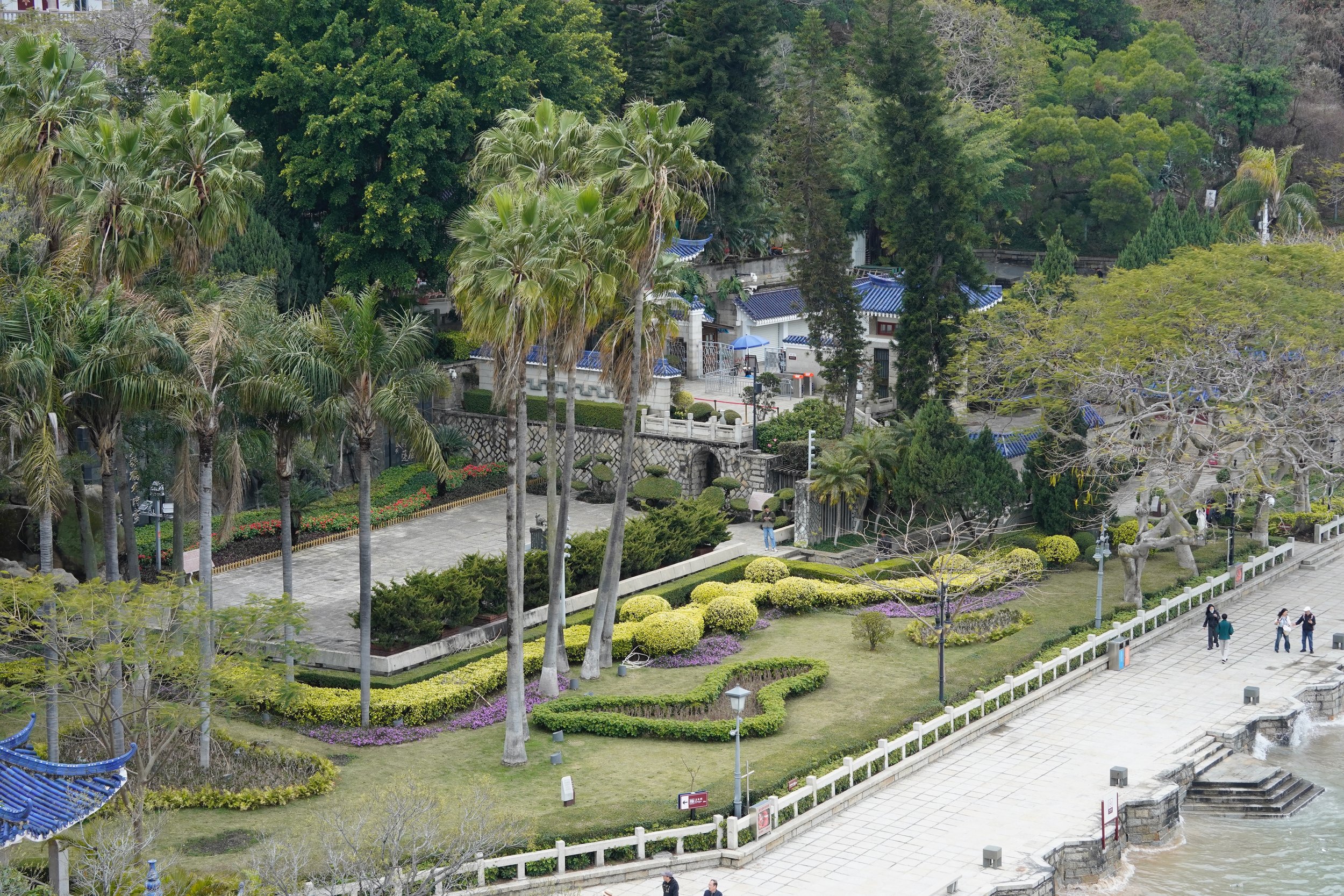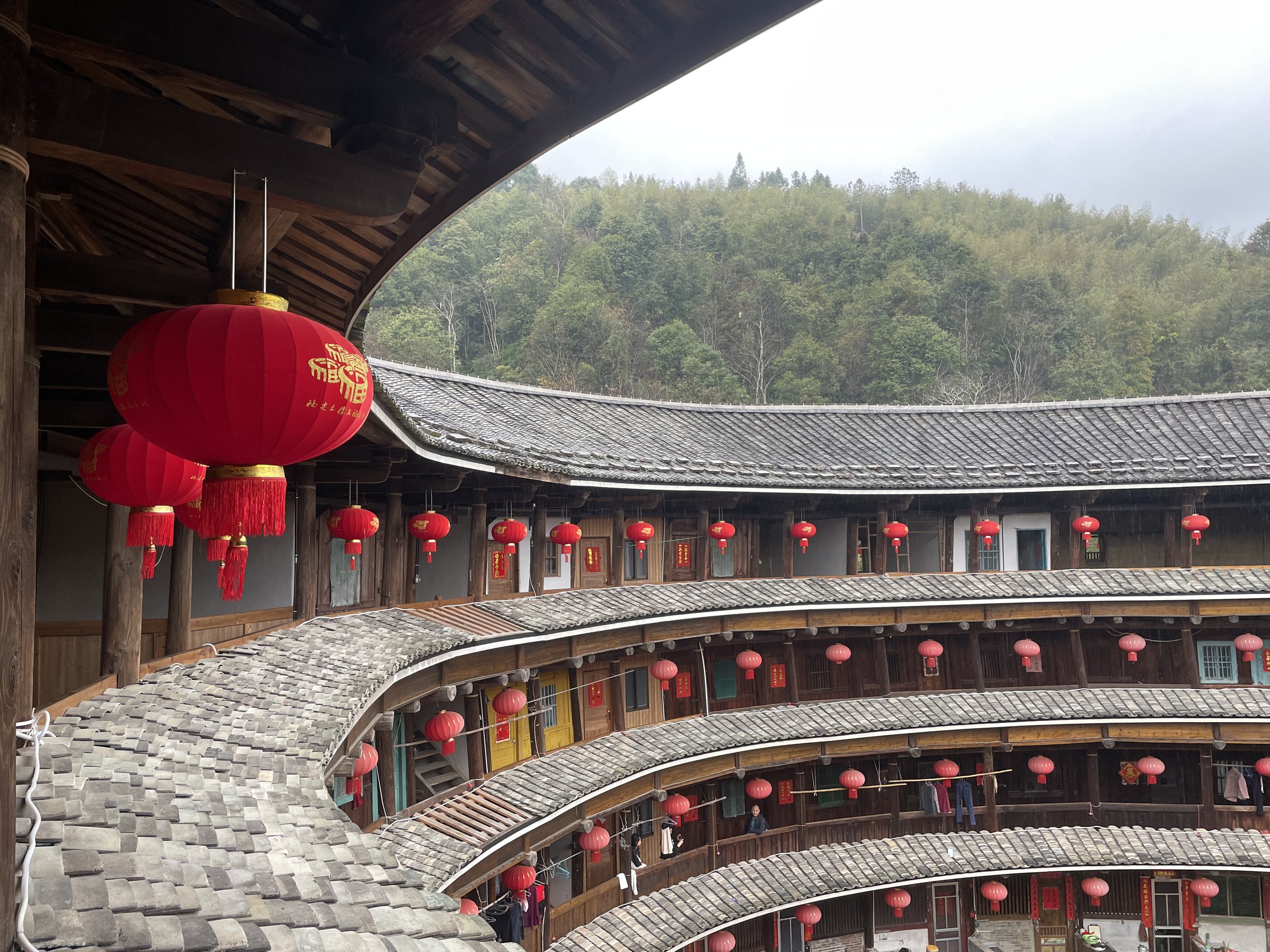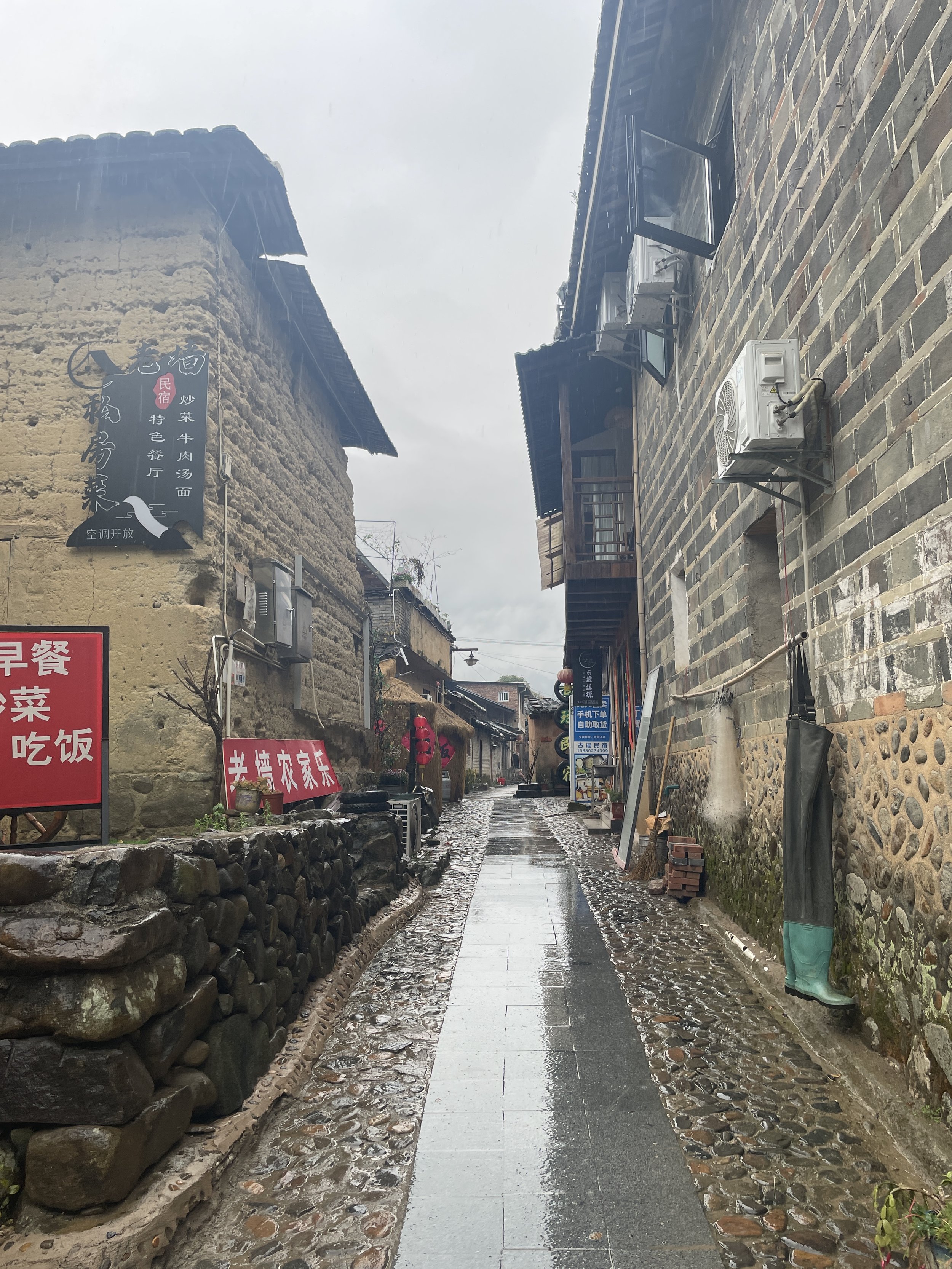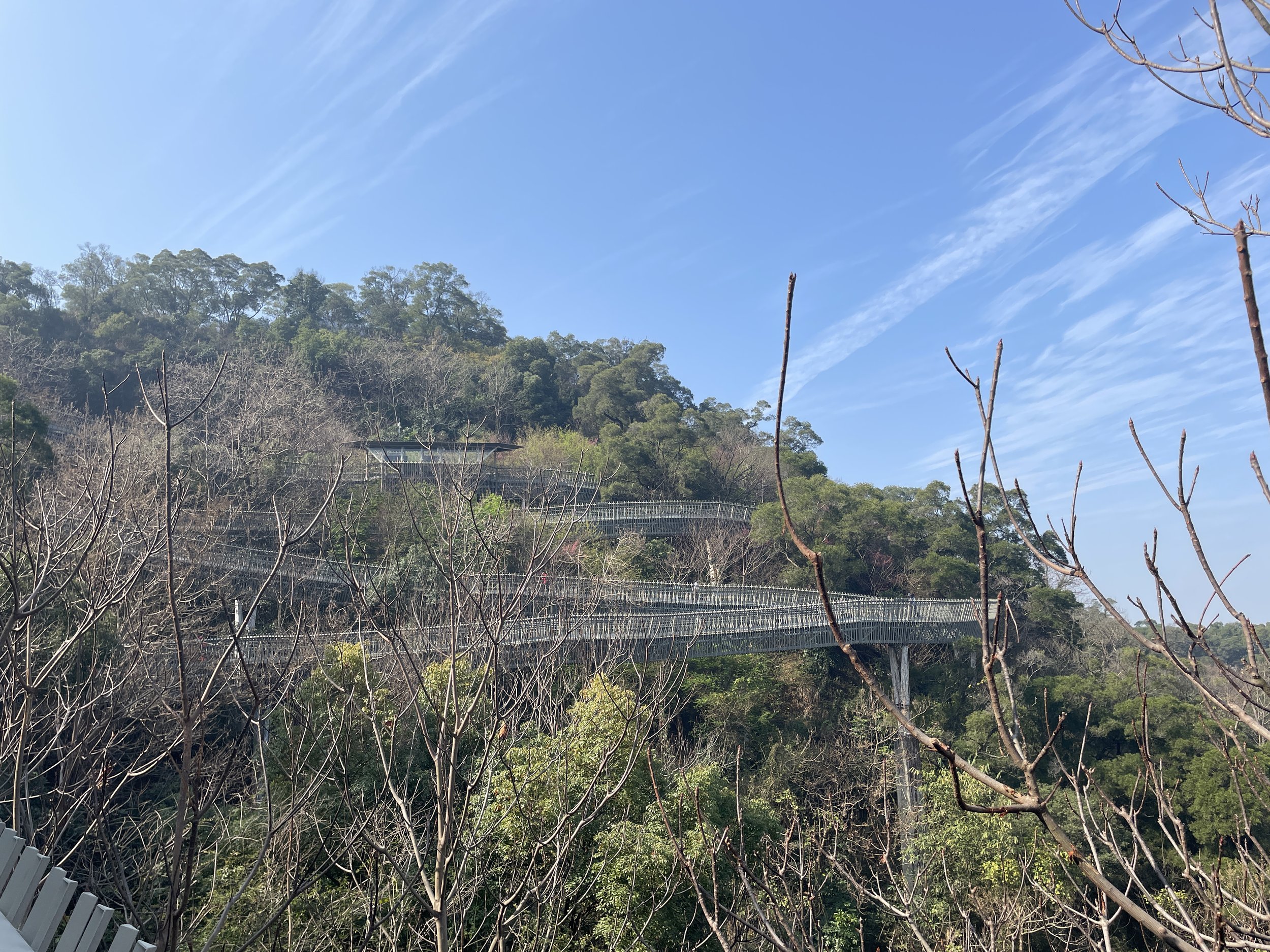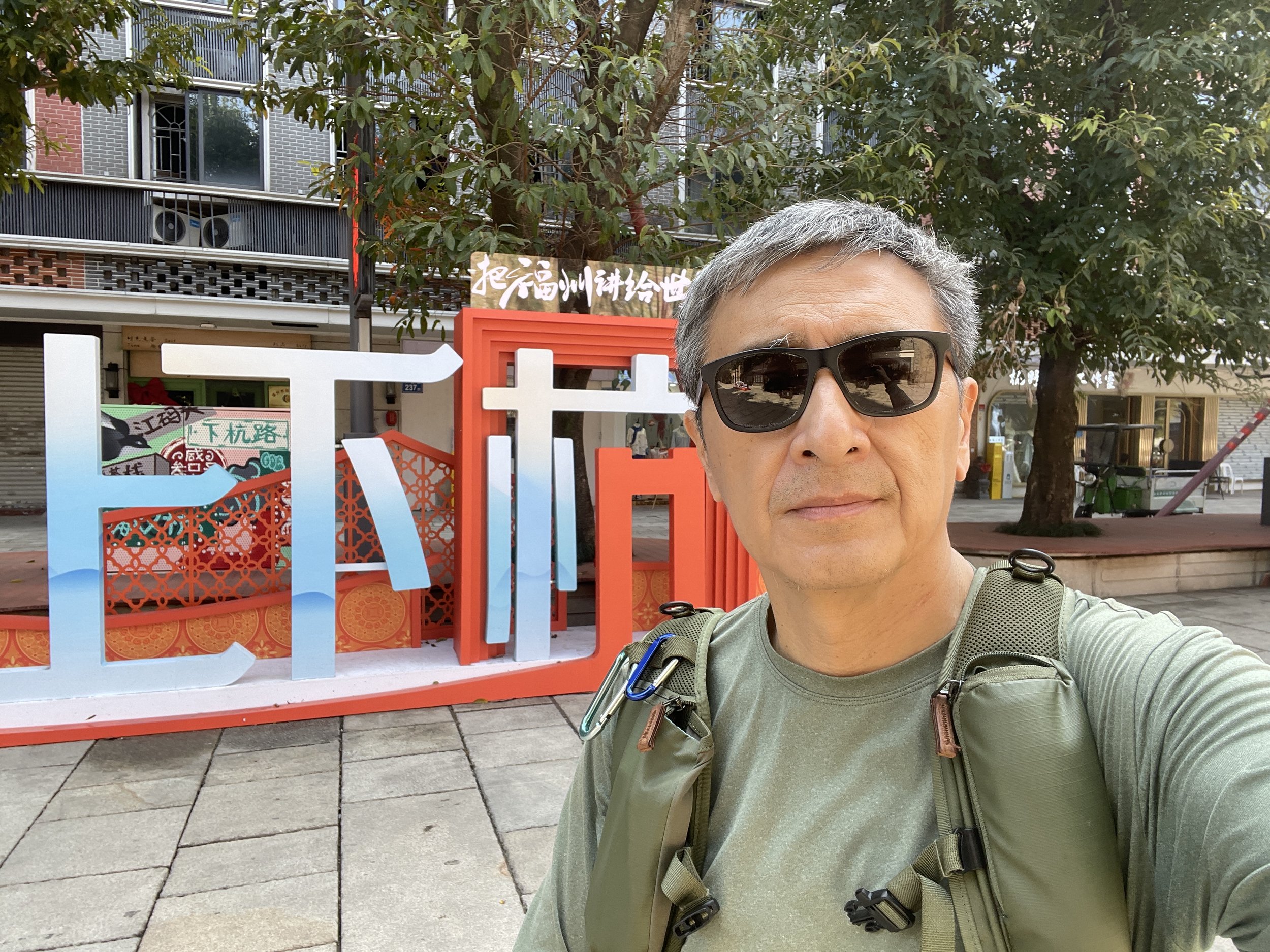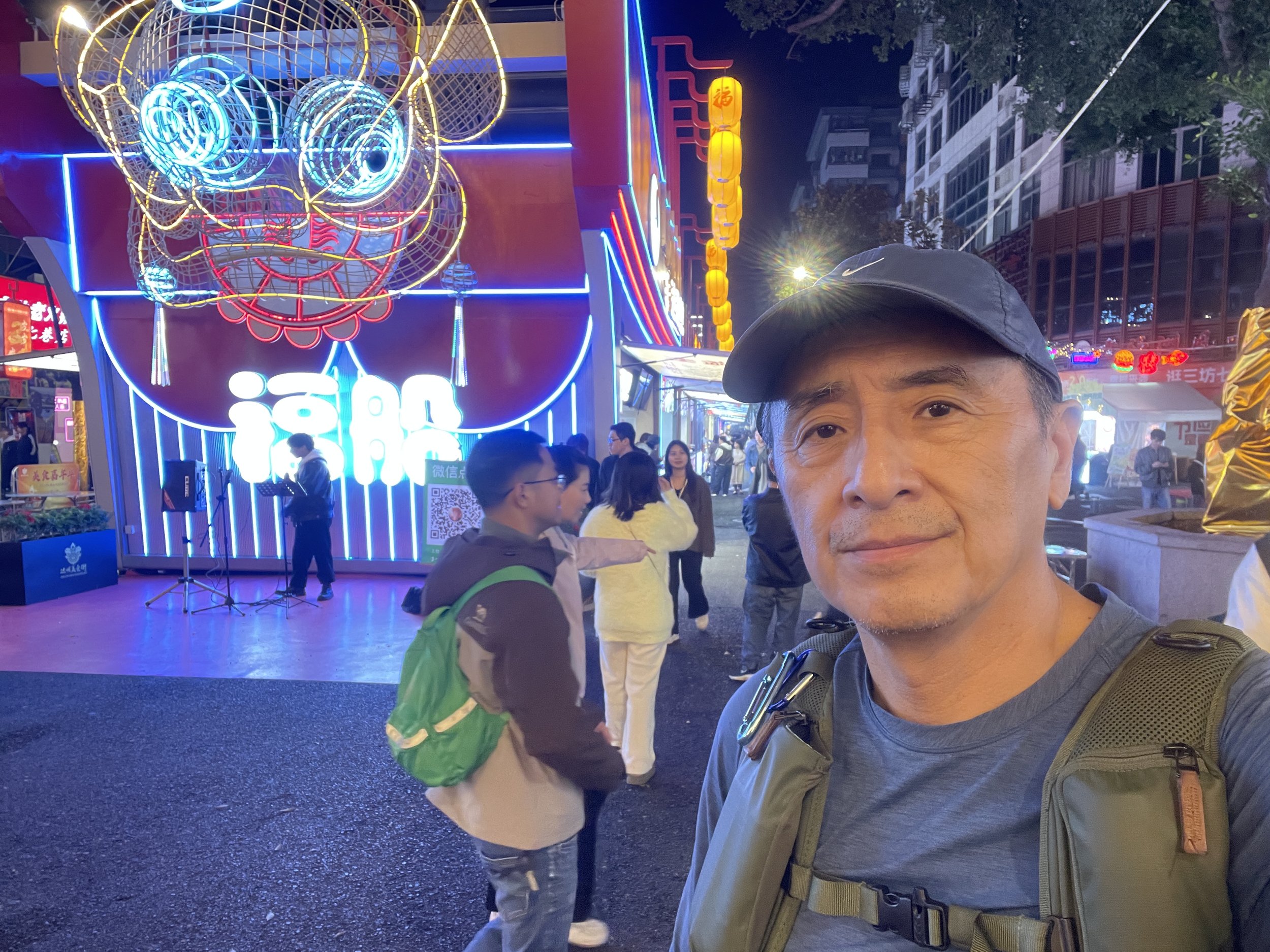Golden Triangle 3-Days Tour – Agra 金三角包车游—阿格拉
March 15, 2025
Yesterday afternoon, we drove for over three hours……
昨天下午驱车三个多小时从新德里来到阿格拉,。。。
March 15, 2025
Yesterday afternoon, we drove for over three hours from New Delhi to Agra and went straight to the hotel to rest.
Early this morning at 6 a.m., our driver arrived at the hotel on time to pick us up. After a short drive, we reached one of the Seven Wonders of the World—the Taj Mahal. We met our local guide at the entrance, who then led us into the site. A quick note here: security checks at the Taj Mahal are separated by gender, and all small bags must go through security scanning, separated from their owners for some time. After the check, visitors have to squeeze through the crowd to find their bags on a long table behind a jam-packed conveyor belt—extremely chaotic and quite insecure.
Even though we had seen countless photos and films of the Taj Mahal, witnessing it in person was still awe-inspiring. Our guide shared the history with us: the Taj Mahal was commissioned by Mughal Emperor Shah Jahan in memory of his wife Mumtaz Mahal, and took 22 years (1632–1653) of meticulous craftsmanship to complete. Since we arrived early, the crowds weren’t too overwhelming, but there were still lines at the best photo spots. Thankfully, our guide helped us take photos—though rushed, we still managed to capture some beautiful shots.
After the Taj Mahal, we headed to the Tomb of I’timād-ud-Daulah, also known as the Baby Taj—said to have inspired the design of the Taj Mahal. This tomb was built by Nur Jahan, wife of Emperor Jahangir, for her father Mirza Ghiyas Beg between 1622 and 1628. Having just come from the grand and majestic Taj Mahal, this smaller tomb felt rather modest and run-down by comparison.
We then returned to the hotel for breakfast. Afterward, our driver took us to another major attraction—the Agra Fort. Built in the 16th century with red sandstone, this massive structure once served as the main imperial palace of the Mughal Empire. From the fort, we could also catch a distant view of the magnificent Taj Mahal.
In the afternoon, after bidding farewell to our local guide, we embarked on a five-hour drive to Jaipur, our next stop in the Golden Triangle journey.
金三角包车游——阿格拉(Agra)
2025年3月15日
昨天下午驱车三个多小时从新德里来到阿格拉, 直接入住酒店休息。
今天清晨 6 点,我们的司机准时来酒店接我们,经过短暂的车程,我们抵达了世界七大奇迹之一——泰姬陵(Taj Mahal)。当地导游在门口与我们会合之后便带着我们进去。这里要说一下,进泰姬陵的安检男女分开,随身的小包都必须过安检带,且与人分开一段时间,安检之后要人挤人的去让工作人员在堆得满满的传送带后面长桌上找自己包包,非常混乱且不安全。
尽管在无数照片和影视作品中见过它的身影,亲眼目睹泰姬陵的那一刻,依然令人震撼。我们的导游向我们讲述了泰姬陵的历史:它是莫卧儿皇帝沙贾汗(Shah Jahan)为纪念他的妻子穆姆塔兹·玛哈尔(Mumtaz Mahal)而建,经历了 22 年(1632-1653 年) 的精雕细琢才最终完成。我们去的早,人还不算太多,最佳摄影点都必须排队,好在我们有导游帮忙拍照,虽匆忙但还是留下了美照。
离开泰姬陵,我们前往伊特玛德·乌德·道拉陵墓(Baby Taj)——据说是泰姬陵的灵感来源。这座陵墓由莫卧儿皇帝贾汉吉尔的王后 努尔·贾汉(Nur Jahan) 于 1622-1628 年间为她的父亲 米尔扎·基亚斯·贝格(Mirza Ghiyas Beg) 建造。刚看完高大上的泰姬陵,再来看小泰姬,感觉就是一个老破小了。
然后我们回到酒店,吃完早餐后,司机又接我们去另一个景点——阿格拉堡(Agra Fort),这座建于 16 世纪的红色砂岩城堡,曾是 莫卧儿帝国的主要皇宫。在那里,还可以遥望宏伟壮观的泰姬陵。
下午与今天的当地导游告别后,我们开车五小时前往下一站斋浦尔(Jaipur),继续我们的金三角之旅。
Golden Triangle 3-Days Tour—New Delhi 金三角包车游—新德里
March 14, 2025
Our 3-day Golden Triangle tour began……
我们从Viator订了三日金三角包车游,。。。
March 14, 2025
Our 3-day Golden Triangle tour began with a morning pickup from our hotel by a private driver, arranged through Viator. After picking us up, the driver met with our local guide, who stayed with us throughout the day. Due to the Holi celebration, some monuments were closed, but we still managed to explore several of Delhi’s iconic landmarks, making the most of our time in the capital.
Our first stop was Jama Masjid, one of the largest mosques in India. The grand red sandstone structure is a masterpiece of Mughal architecture and continues to be an active place of worship. Like many religious sites in India, we were required to remove our shoes before entering. To avoid walking barefoot, we paid 200 rupees to borrow thin slippers. The mosque was nearly empty, with workers rolling out carpets in preparation for upcoming prayers. Through an open side gate, we caught a glimpse of Chandni Chowk Market, which our guide jokingly referred to as the “thief market.” The usually bustling market was quiet, closed in observance of Holi.
Next, we stopped for photos at India Gate, a war memorial honoring the Indian soldiers who died in World War I and other conflicts.
Due to the Holi holiday closures, our guide suggested an alternative site: Gurdwara Bangla Sahib, a stunning Sikh temple with a golden dome and a peaceful Sarovar (holy pond), which was under renovation. Both of us had to remove our shoes and cover our heads with scarves before entering. It was our first time inside a Sikh temple, and we were fascinated by the worship rituals. We also visited the temple’s langar, the community kitchen that serves over 20,000 free meals daily. While photography was not allowed inside the temple itself—preserving the sacred atmosphere—we were permitted to take photos in the kitchen area. The atmosphere there was truly humbling. People from all walks of life worked side by side, chopping vegetables, washing dishes, baking bread, and serving food. Witnessing this spirit of selfless service was deeply inspiring, and the sheer scale of the operation left a lasting impression.
We then visited Qutub Minar, a UNESCO World Heritage Site and the tallest brick minaret in the world. Built in the 12th century, the towering structure is covered in intricate carvings and Arabic inscriptions from the Delhi Sultanate period. Remnants of an earlier Hindu temple stand beside the mosque, reflecting a history of religious transitions—a pattern we observed throughout India.
Our final stop in Delhi was the Lotus Temple, a Baha’i House of Worship known for its lotus flower-like architecture. Open to people of all faiths, the temple offers a serene space for silent reflection. We waited briefly before entering and sat quietly inside for a few minutes to absorb the tranquil atmosphere. The surrounding gardens were beautifully maintained.
Given the general concerns about hygiene among foreign visitors, our driver took us to a trusted restaurant catering to tourists. It offered both Indian and Chinese dishes. The clientele was entirely foreign, and we ordered butter chicken and Chinese noodles, both of which were satisfying.
Our local guide was knowledgeable and engaging, offering detailed insights into the history and cultural significance of each site. He also served as our photographer, which meant we didn’t have to rely on selfies—a thoughtful touch that made the experience even more enjoyable.
After lunch, we began the 3-hour drive to Agra. That night, we checked into the Holiday Inn, where dinner was included in our package. The buffet-style meal was decent and convenient after a long day of travel and sightseeing.
金三角包车游—新德里
2025年3月14日
我们从Viator订了三日金三角包车游,配一位私人司机和三位当地导游。今天是第一天,主要是在新德里转转。早餐之后司机先从酒店接上我们俩,再前往接当天陪同我们的当地导游。由于今天仍是洒红节(Holi Festival),一些景点关闭,但我们仍然游览了多个标志性景点,充分利用了在印度首都的时间。
我们的导游详细讲解了每个景点的历史和文化背景,使我们能够按照自己的节奏慢慢探索。他还兼职摄影师,帮我们拍下了许多美照,无需自拍,令旅程更加愉快。
新德里游览景点
贾玛清真寺(Jama Masjid)—— 印度最大的清真寺之一,这座 红砂岩建筑是莫卧儿建筑的杰作,至今仍是重要的宗教场所。打开侧门时,我们远望一处被导游称为 “小偷市场”的Chandni Chowk 市场。
印度门(India Gate) —— 印度战士纪念碑,矗立在新德里市中心,以纪念在战争中牺牲的印度士兵。P?锡克庙(Gurdwara Bangla Sahib) —— 一座宏伟的锡克教寺庙,金色圆顶在阳光下熠熠生辉。我们按照规定包上头巾,脱掉鞋袜,淌过水进入寺中,圣徒们坐在地上聆听颂经。里面不允许拍照。我们还参观了免费施食厨房(Langar),这里每天为2万人提供餐食,体现了锡克教的博爱精神。
古塔(Qutub Minar) —— 联合国教科文组织世界文化遗产,世界上最高的砖砌宣礼塔。
莲花寺(Lotus Temple) —— 巴哈伊教礼拜堂,以莲花造型闻名。这里的宁静氛围为游客提供了一个静思冥想的空间,对所有信仰的人开放。
在一天的游览结束后,我们享用了一顿美味的午餐,包括奶油黄油鸡(Butter Chicken) 和 中式炒面(Chinese Noodles),为这趟充满文化与历史的旅程增添了一份美食的满足感。
告别新德里及当地导游,司机载着我们前往三日游的下一站Agra。
Holi Festival 洒红节
March 12, 2025
Chenggang flew to New Delhi from Hanoi,……
当我们于2025年3月12日抵达新德里时,。。。
March 12, 2025
Chenggang flew to New Delhi from Hanoi, Vietnam with Vietnam Airlines, while Connie arrived on a United Airlines flight from New York City. We both enjoyed some relaxing time in our respective airport lounges before our flights. Connie landed in New Delhi about an hour earlier than Chenggang, and we met at the baggage claim area.
As we stepped out of the arrival gate, we saw a hotel representative holding a sign with our name. Shortly after, we were escorted to our car, and the hotel driver drove us to the hotel.
On the way, the driver mentioned that the next two days would be filled with vibrant Holi celebrations across India. Holi is one of the country’s most joyful and colorful festivals, marking both the arrival of spring and the victory of good over evil. It’s famously known as the “Festival of Colors,” with people joyfully throwing colored powders (gulal) at one another in celebration.
March 13, 2025
This morning, we set out to explore Delhi on our own, without a guide. The hotel driver dropped us off at Aerocity Mall, but since most shops hadn’t opened yet, we decided to head to the nearby metro station. To our surprise, the newly built station wasn’t directly connected to the mall as we had expected—we had to circle around the mall to reach the entrance.
Once inside, we found the Delhi Metro to be a pleasant surprise: modern, clean, and nearly empty. We took the train to a stop near Connaught Placeand Central Park, but as we exited the station, we were quickly overwhelmed by large crowds on the streets—and even saw monkeys roaming freely, which was both surprising and a bit amusing.
As we made our way toward Central Park, a man approached us, claiming the park was closed and recommending a “nice shopping mall” nearby instead. Believing he might be referring to Connaught Place—our intended destination—we hesitated. A second man then joined the conversation and offered to walk with us. Though he may have meant well, we started to feel uneasy, especially as we walked into a neighborhood that didn’t feel particularly safe or clean.
About 10 minutes later, we arrived at Dilli Haat, an indoor handicraft market. While the market was interesting and featured a variety of local crafts, it wasn’t quite what we were looking for—we hadn’t planned to shop for souvenirs or clothes. Overall, it was a disappointing start to our day and not the experience we had hoped for.
After just a brief look around, we left and decided to trust Google Mapsinstead of unsolicited advice from strangers. That turned out to be the right call.
Contrary to what we’d been told, Central Park and Connaught Place were both open. We strolled around the famous circular market area, though nothing in particular caught our interest. So we returned to Aerocity for a simple lunch at the mall’s food court. The hotel driver picked us up afterward and brought us back to the hotel.
In the afternoon, we were invited to join the Radisson Blu hotel staff for their Holi celebration. From the moment we arrived, they made us feel welcome—handing us cheerful “Happy Holi” white t-shirts and playfully smearing colorful powders on our faces.
They had prepared a spectacular buffet of Indian cuisine, along with an open bar, and the atmosphere was absolutely electric. With music playing, people dancing, and laughter all around, we found ourselves fully immersed in the festive spirit. We danced, laughed, and joined in the celebration with total spontaneity.
It was a truly unforgettable afternoon, filled with warmth, joy, and cultural connection—one of the most unexpected yet delightful moments of our trip. Holi turned out to be not just a festival of colors, but also a celebration of community, generosity, and the beauty of shared experiences.
洒红节
当我们于2025年3月12日抵达新德里时,接我们的酒店司机告诉我们,接下来的两天将是印度充满欢乐的洒红节。洒红节是一个充满活力的节日,象征着春天的到来和正义战胜邪恶。它也被称为“色彩节”,因为人们会互相抛洒彩色粉末来庆祝。
3月13日,我们与Radisson Blu酒店的员工一起参加了洒红节的庆祝活动。他们热情地为我们提供了白色T恤,并在我们的脸上涂上了五彩斑斓的颜料。此外,他们还准备了丰盛的印度美食和开放式酒吧,款待大家。现场气氛热烈,我们随着音乐起舞,欢声笑语不断,尽情享受着印度美食和节日的狂欢。这个下午充满了惊喜与欢乐,让我们沉浸在这场意想不到的文化体验之中。
Hanoi Hop-On Hop-Off Bus Tour
March 11, 2025
The breakfast at Le Premier Hotel was extensive,……
March 11, 2025
The breakfast at Le Premier Hotel was extensive, and their pho was arguably the best in town. I was usually among the first guests to arrive each morning, allowing me extra time to relax and prepare before heading out for the day’s adventures.
Today, I decided to take the Hop-On Hop-Off bus—a flexible and convenient way to explore Hanoi’s key landmarks at my own pace. Since I was staying at Le Premier Hotel near Hoàn Kiếm Lake, I boarded the bus at Dong Kinh Nghia Thuc Square, a central and bustling spot.
My first stop was the Ho Chi Minh Mausoleum, where the embalmed body of Vietnam’s revolutionary leader rests. The square was vast, surrounded by government buildings and historical landmarks. A long queue had already formed, and it took me at least 30 minutes to enter and view the body. The atmosphere inside was solemn, with strict rules ensuring silence and respect.
Just a short walk away was the One Pillar Pagoda, an ancient Buddhist temple uniquely built on a single stone pillar rising from a lotus pond. Despite its modest size, the pagoda carries deep historical and spiritual significance.
Next, I visited Quan Thanh Temple, a Taoist temple dedicated to Tran Vu, the deity of the north. The temple’s intricate carvings, peaceful courtyard, and giant bronze statue made this stop a pleasant and culturally enriching experience. What really caught my attention was the food and drinks people put on the altars—stuff they hope their family and the gods can enjoy in the afterlife.
By the time I reached Tran Quoc Pagoda, it was closed for lunch. I wandered around looking for a place to eat and ended up at a nearby restaurant for a bowl of pho. But it gave me an opportunity to walk around the area where locals live. Unfortunately, it turned out to be the worst pho I’d ever had—the broth was bland, the beef tasted like cardboard, and the flavors were disappointingly flat.
After lunch, I returned to Tran Quoc Pagoda, one of Hanoi’s oldest Buddhist temples, perched on a small peninsula by West Lake. Its tall red pagoda reflected in the still water created a serene and picturesque scene.
I made a quick stop at the bright yellow Cửa Bắc Church (Northern Gate Church), a charming blend of French and Vietnamese architectural styles. Just across the street stood the ancient Northern Gate, still bearing two cannon holes from the French attack—a quiet reminder of the city’s turbulent past.
The next stop was the Imperial Citadel of Thang Long, a UNESCO World Heritage Site that had served as Vietnam’s political center for over 1,300 years. Exploring the ancient gates, archaeological ruins, and hidden wartime bunkers offered a fascinating glimpse into Hanoi’s layered past. The highlight was the D67 Building, a wartime bunker and command center used during the Vietnam War. Walking through its rooms felt like stepping back in time.
I then arrived at the Temple of Literature, Vietnam’s first national university, founded to honor Confucian learning. Its serene courtyards, carefully manicured gardens, and peaceful pavilions provided a refreshing escape from the city’s hustle. The highlight was the 82 stone stelae, each resting on a turtle base and inscribed with the names of scholars who passed the royal exams between 1442 and 1779—a powerful tribute to Vietnam’s long-standing reverence for education.
However, this stop came with an unexpected challenge. Unlike other sites, where visitors could exit at the same point, the Temple of Literature required exit through a designated gate far from the bus stop. By the time I made it back, the scheduled bus had already left!
Just then, my friend called—he was already waiting for me in the hotel lobby for dinner. I called Grab, a ride sharing app to a restaurant for us to meet. The wonderful restaurant was special for Vietnamese stir-fried fish. It was absolutely delicious.
After bidding farewell to my friend, I walked to the Thang Long Water Puppet Theater to try for a last-minute ticket to the 8:00 p.m. show. Although a “sold out” sign was posted, I decided to queue anyway—and luckily, there were one or two tickets left! I thoroughly enjoyed the show; it was lively, entertaining, and uniquely Vietnamese.
To cap off the evening, I boarded the Hop-On Hop-Off Night Bus, taking the same route without getting off. The city had transformed—its streets alive with lights, scooters, and the vibrant energy of Hanoi’s nightlife.
March 12, 2025
With a full morning free before heading to the airport for my next journey, I made my way to the legendary Cafe Giang to try their famous egg coffee. The drink was unique—rich, creamy, and surprisingly delicious. It was the perfect way to end my memorable stay in Hanoi.
HaLong Bay 下龙湾
March 10, 2025
Yesterday, I flew from Shenzhen to Hanoi……
March 10, 2025
Yesterday, I flew from Shenzhen to Hanoi and had a driver pick me up, which I had booked through Booking.com. I was glad I did, as the arrival area was chaotic, with crowds of people searching for taxis. Navigating my way out on my own would have been challenging.
The roads were heavily congested, and by the time we reached the area near my hotel after 7 PM, the streets had been closed off for the weekend. The driver had to drop me off a short walk away, so I dragged my luggage through the bustling crowd.
After settling into my hotel, I enjoyed my first delicious Vietnamese dinner there. Later, I headed out to Hoàn Kiếm Lake, where a lively celebration was taking place. A free concert was happening near the lake, but since I didn’t recognize the singers or the songs, I opted for a leisurely walk around the lake, soaking in the vibrant atmosphere.
On my way back, I had to take a few detours, as some streets were also closed off to pedestrians, making the walk back to my hotel a bit more of an adventure.
I booked a day tour to Ha Long Bay, located about 170 km from Hanoi, through Viator. It is one of Vietnam’s most famous natural wonders, renowned for its breathtaking karst landscape, emerald waters, and thousands of limestone islands.
Today, I was picked up at 8 AM as one of the first passengers. For the next hour, the driver drove around Hanoi’s Old Quarter, picking up other tourists. Then, we had a three-hour drive to the bay, with a 30-minute stop at a pearl farm shop, where they tried to sell us pearl products.
At the marina, 36 of us from the same bus boarded a tour boat. Each table seated six people, and lunch was served as the boat sailed toward Ti Top Island. The meal included a variety of seafood and vegetarian dishes, all of which were delicious.
On Ti Top Island, we hiked up 400 steps, which were quite crowded. However, at the summit, we were rewarded with a panoramic view of Ha Long Bay. Some of the passengers from our boat also took a swim at the island’s small beach.
Our next stop offered three activity options: kayaking, riding a paddling boat, or riding a speedboat. The speedboat was the only option that required an extra fee of $10, which I chose. The driver took us out into the open waters at high speed, bringing us up close to several rock formations. He also performed high-speed maneuvers, making the ride thrilling. The view of the limestone formations from the boat was absolutely breathtaking.
The final stop was a visit to a cave on the island. The narrow path leading to the cave was crowded initially, but once inside, the space felt much larger. The caves were interesting but not particularly spectacular compared to others I’ve seen.
As we cruised back to the marina, the scenery of Ha Long Bay was simply stunning. The towering limestone islands, shimmering water, and peaceful atmosphere made the entire experience unforgettable.
After a three-hour bus ride back to Hanoi, I met up with a friend from Phoenix at my hotel. He took me out to try some local favorites: pho, bánh mì, and spring rolls. The food was flavorful and authentic. After dinner, we took a walk around Hoàn Kiếm Lake, where the night views were charming. It was my first full day in Vietnam and a fantastic way to start the trip.
Macau 澳门
March 8, 2024
Yesterday, I visited my maternal uncle and his family in Panyu……
March 8, 2024
Yesterday, I visited my maternal uncle and his family in Panyu. The journey from Shenzhen took about 2.5 hours door-to-door via high-speed train and two subway transfers. I hadn’t seen them for decades, making the reunion both emotional and heartwarming.
Today was another packed travel day as I set out to visit Macau. Before heading to the ferry terminal at Shekou, I made a detour to Talent Park, where I took a leisurely stroll. The park was beautiful, and I wished I had more time to enjoy it.
From there, I called a Didi to the ferry terminal. Initially, I was seated in second class on the lower deck, where the seats were narrow and somewhat cramped. After a few minutes, I decided to upgrade to first class on the upper deck for ¥170. The upgrade was well worth it—there were only four passengers in the spacious and comfortable section, and the service included hot coffee and snacks. The sea crossing to Macau took about an hour.
Upon arrival, I took a free casino shuttle—amusingly called the “Getting Rich Shuttle”—to MGM Cotai. From there, I transferred to MGM Macau on Macau Island. The casino was bustling, the air filled with excitement, but since I wasn’t interested in gambling, I headed straight to the food court. I had clay pot rice (煲仔饭), which was delicious and suited my taste perfectly.
Afterward, I wandered around the area. Compared to Las Vegas, Macau’s casino district felt less glamorous. I took another free casino shuttle from Grand Lisboa back to Lisboeta in Taipa island. Then, I strolled from Lisboeta to MGM Cotai, passing by the impressive Wynn Cotai water fountain. The area around Wynn was noticeably more upscale and scenic.
After five hours in Macau, during which I visited four casinos across two different islands, I returned to the ferry terminal.
With this trip, I have now visited all of China’s territories: Mainland China, Taiwan, Hong Kong, and Macau—fulfilling one of my lifelong dreams.
In Shenzhen, I stayed at the Atour Hotel next to Huaqiangbei, the world’s electronics capital. I explored several massive, multi-level malls offering everything from surface-mount resistors and capacitors to drones and laptops. I was blown away by the sheer scale and diversity of electronic systems and components available. Huaqiangbei is truly a global hub for electronic supply and innovation.
Gulangyu Island 鼓浪屿
March 5, 2025
I took the 9:45 AM ferry from the First Ferry Terminal……
March 5, 2025
I took the 9:45 AM ferry from the First Ferry Terminal to Neicuo’ao. It was supposed to be a luxury ferry, but aside from everyone having their own seat, there was nothing luxurious about it—yet it cost twice as much as the standard ferry. After a short ride, I arrived at the terminal, only to be met with a shock: a dilapidated seaside building stood not too far away, immediately giving me a bad first impression. I had expected Gulangyu to be a high-end resort town with beautiful ocean views and stunning beaches, but instead, I continued to spot several more abandoned buildings occupying prime locations.
Before the trip, I had done my research, and my main goal was to walk along the coastline. I even bought an island map on the ferry to assist me. However, that plan quickly fell apart. Without any warning signs or notices, I found that several footpaths were inaccessible, either under repair or flooded. After walking downhill, I—along with other confused visitors—had no choice but to turn back and take the main roads instead. The scenic area was poorly managed, at the very least.
However, Sunlight Rock (日光岩) was an exception. The area was beautifully designed and well-maintained. As the highest point on the island, it offered panoramic views of both Gulangyu and Xiamen.
I had originally planned to visit Shuzhuang Garden, but after seeing so many traditional gardens on past trips, I decided to skip it. Instead, I went to Haoyue Park, home to the giant statue of Zheng Chenggong, the historical figure who played a key role in reclaiming Taiwan from Dutch rule in the 17th century. Unlike other parts of the island, this theme park was spacious, well-designed, and offered even more breathtaking views of Xiamen and its surroundings. I truly enjoyed my visit there.
When it was time to leave, I encountered yet another frustrating inconvenience. I was not allowed to board the short ferry back to Xiamen, as it was only for locals. Instead, I had to walk an extra 15 minutes to another ferry terminal and take a 25-minute ferry that dropped me off far from my hotel. This unnecessary detour wasted everyone’s time and fuel, not to mention its environmental impact.
After returning to Xiamen, I had one more stop: Nanputuo Temple (南普陀寺). I booked a Didi ride, but once I got in the car, the driver tried to trick me into taking a longer route by claiming the temple was about to close soon. I told him, “Just take me there, open or not.”
As expected, the temple was still open for another two hours. It was beautifully designed and well-maintained, a stark contrast to the disappointment of Gulangyu. I really enjoyed the visit.
I had skipped lunch, so for dinner, I had a simple teppanyaki fried noodles (铁板烧炒面) for ¥28. Simple, but satisfying.
Four Dishes and One Soup 四菜一汤
March 4, 2025
Today, I joined a small group tour to visit Nanjing Tulou,……
March 4, 2025
Today, I joined a small group tour to visit Nanjing Tulou, one of the most famous tulou clusters in China. Our group consisted of five adults and a three-year-old girl. I was the last person to be picked up at 9 AM, and since I was the only solo traveler, I was lucky to get the comfortable front seat in the van. The drive from Xiamen to the scenic area took about two hours.
Upon arrival, I encountered a minor issue with ticket verification—the tour company couldn’t use my passport to purchase the ticket, so they used another person’s ID number instead. At the entrance, I was instructed to tell the attendant that I didn’t have the physical card, only the number. However, the deception was obvious because Chinese ID numbers include the birth year, and I was clearly not born in 1983, which is on the ID. Fortunately, the attendant didn’t question it too much, and I was able to enter without any problems.
Just as our tour started, rain began to fall, so we walked around with umbrellas in hand.
Our first stop was Hegui Lou, built in 1732. This is the tallest square tulou in Fujian, standing at five stories high. It was constructed in a marshy area, relying on wooden columns for support, giving it the appearance of floating on water. Inside, the wells have water levels slightly above the ground, reinforcing its name as the “Water Tulou.”
Next, we visited Cuimei Lou, which wasn’t included in the tour package, so we paid an extra $1.50 to explore the upper floors. Since this tulou was not part of the organized tour, it was much quieter—an excellent spot to admire the architecture and take photos without the usual crowds.
We then strolled through Yunshuiyao Ancient Village, known for its centuries-old banyan trees, cobblestone streets, and flowing rivers, creating a peaceful and poetic atmosphere. However, due to the gloomy weather, the village failed to impress me.
Our next stop was Zhongxing Lou, a square-shaped tulou that now serves as a tulou museum. We were allowed to go up to the upper floors and balconies, which provided a better view of Huaiyuan Lou, our next destination.
Built in 1907, Huaiyuan Lou is one of the best-preserved and most beautiful round tulou in Fujian. It features exquisite wooden carvings and perfectly symmetrical architecture, making it a prime example of classical tulou design. Traditionally, each floor had a specific purpose: the first floor was used as a kitchen and cooking area, the second floor for storage, the third and fourth floors for living quarters, and the fifth floor for miscellaneous purposes, including storing coffins before burial. Nowadays, very few people still live inside the tulou, except for some elderly residents.
After lunch, we visited Yuchang Lou, one of the oldest and largest round tulou in Fujian, built in 1308 during the Yuan Dynasty. This tulou is famous for its tilted wooden columns on the upper floors, which lean significantly due to construction errors, yet the structure has remained standing for over 700 years. Inside, every room on the first floor had a well—a rare feature.
Without a doubt, the best part of the tour was saved for last. The Tianluokeng Tulou Cluster, nicknamed “Four Dishes and One Soup,” did not disappoint. This world-famous site features four round tulou surrounding a square tulou, forming a layout that resembles a traditional Hakka meal, with the round tulou representing four dishes and the square tulou symbolizing a bowl of soup. The aerial view of this cluster is iconic and breathtaking.
Despite the rainy start, the day turned out to be an unforgettable experience, offering a deep insight into Hakka culture, history, and architectural wonders.
Fu Dao 福道
March 1, 2025
Today’s highlight was undoubtedly my hike on Fu Dao (福道),……
今天最精彩的体验无疑是徒步福道(Fu Dao),。。。
March 1, 2025
Today’s highlight was undoubtedly my hike on Fu Dao (福道), one of the most scenic urban trails in Fuzhou and often hailed as “China’s most beautiful city forest walkway.” Stretching approximately 19 kilometers, this elevated steel skywalk winds through various city parks, seamlessly integrating nature with urban life. I took the 5-kilometer classic route, and the panoramic city views along the way were absolutely breathtaking. The Fu Dao design and construction were impressive.
After the hike, I headed to Shangxiahang (上下杭), similar to three lanes and seven alleys, another historical district in Fuzhou, known for its well-preserved traditional architecture, old merchant houses, and charming riverside scenery. I had lunch there—the food was good, but I ordered too much and couldn’t finish everything.
Next, I visited Yantai Mountain Park (烟台山公园) and its historic streets, but the overwhelming crowds made the experience less enjoyable. The area has a rich history, but I found it difficult to appreciate with so many people around.
Later in the day, I crossed a bridge over the Min River (闽江) and called a Didi to Gushan Shibajing Park (鼓山十八景公园), hoping to catch the sunset. Unfortunately, the weather was cloudy, and the summit was packed with visitors. I spent only a few minutes there before deciding to head back to my hotel.
I had a light dinner at a nearby restaurant and called it a day.
2025年3月1日
今天最精彩的体验无疑是徒步福道(Fu Dao),这条被誉为“全国最美城市森林步道”的福州著名城市步道。福道全长约19公里,由架空的钢结构栈道组成,穿行于多个城市公园之间,将自然与都市完美融合。我选择了经典的5公里路线,从3号口进5号口出,一路上城市的全景美不胜收,令人惊叹。这条步道确实名不虚传。
徒步结束后,我前往上下杭(Shangxiahang),这片历史街区与三坊七巷相似,以保存完好的传统建筑、古商铺以及富有韵味的沿河景观闻名。我在这里享用了午餐,食物很不错,但点得有些多,没能吃完。
接着,我前往烟台山公园(Yantai Mountain Park)及其周边历史街区。然而,人潮汹涌,使得游览体验大打折扣。尽管这里历史底蕴深厚,但在熙熙攘攘的人群中,我很难静下心来细细感受。
傍晚时分,我步行穿过闽江(Min River)上的一座桥,叫了滴滴前往鼓山十八景公园(Gushan Shibajing Park),希望能在山顶欣赏日落。然而,天气阴沉,山顶游客众多,景色并不如预期。我仅停留了几分钟,便决定返回酒店。
晚餐随意找了一家餐馆简单吃了些东西,随后便结束了这一天的行程。
Three Lanes and Seven Alleys 三坊七巷
February 28, 2025
Today marked the beginning of my first solo travel journey……
今天是我首次独自旅行的第一天。。。
February 28, 2025
Today marked the beginning of my first solo travel journey. I took a four-hour high-speed train to Fuzhou, the capital of Fujian Province. The ride was smooth, and I had pre-ordered lunch from a restaurant in Jinghua City through the 12306 railway app the day before. At Jinghua Station, a train attendant delivered my meal. While the food was average, the experience of having a pre-ordered meal delivered mid-journey was certainly unique.
Upon arriving at Fuzhou Station, I took a short Didi ride to the Hampton by Hilton for less than $3. After a brief rest, I set out to explore the city on foot. A 50-minute walk led me to Three Lanes and Seven Alleys (三坊七巷), a historic district known for its well-preserved Ming and Qing dynasty architecture. The area was lively, lined with tea houses, local shops, and street food vendors. The most photographed attraction was a heart-shaped tree, but overall, the district felt similar to other historic pedestrian streets across China—a blend of old-world charm and modern commercialization.
For a local snack, I tried fish ball and Rouyan soup, both Fuzhou specialties. While they were decent, they didn’t quite impress me. Dinner, however, was a different story. I ordered lychee pork (荔枝肉) and another dish, both of which were delicious and full of flavor. On my way back to the hotel, I passed through a bustling night food market, but despite the tempting aromas, I resisted the urge to try anything more.
2025年2月25日
今天是我首次独自旅行的第一天。我搭乘了四小时的高铁来到福州,福建省的省会。旅途十分顺利,昨天在铁路12306App上提前预订了来自金华某餐厅的午餐。到达金华站后,列车员准时送来了餐食。虽然味道一般,但这种服务方式倒是颇具特色。
抵达福州站后,我叫了一辆滴滴,不用3美元就到了入住的希尔顿欢朋酒店。稍作休息后,我步行50分钟前往三坊七巷,一片保存完好的历史文化街区,充满了明清时期的古建筑。这里有许多茶馆、小店,以及各种当地特色小吃。最受欢迎的景点是一棵心形树,许多游客在此拍照留念。不过,整体逛下来,三坊七巷的体验与国内许多类似的历史街区相似,新旧交融,也略显商业化。
途中,我尝试了鱼丸和肉燕汤,这是福州的传统小吃。然而,味道一般。晚餐则完全不同,荔枝肉和糟菜炒笋香味俱全,让人食欲大增。回酒店的路上,我路过了一条热闹的夜市,摊位上飘来阵阵诱人的香气,但我最终还是没有继续品尝更多小吃。
Taihu Ancient Town 太湖古镇
February 6, 2025
After enjoying a lavish breakfast at the Sun Hotel,……
在太阳酒店享用了一顿丰盛的中西式自助早餐后,。。。
February 6, 2025
After enjoying a lavish breakfast at the Sun Hotel, which included both Western and Chinese buffet options, we called a Didi to head to another famous landmark in Huzhou — the Moon Hotel by Taihu Lake. The hotel also earned an unflattering nickname due to its unique design. The drive from Sun Hotel in Nanxun to the Moon Hotel by Taihu Lake took about fifty kilometers, and along the way, we realized that Huzhou was much larger than we had anticipated.
After checking in, we decided to explore the city. Our first stop was Yishang Street. While there were plenty of people, most of the street food sold by the vendors were common to many other places in China, with little to distinguish them, so we quickly lost interest and left. Next, we visited Zhuangyuan Street and Xiaoxi Street. The area wasn’t large, but it had its own charm, and it was definitely worth a visit. We got tired from walking, so we ducked into a small alley and took a break in a cozy café. The coffee was quite good, and the ambiance was peaceful and relaxing.
For dinner, we chose a restaurant by Taihu Lake, where we ordered a set meal featuring Taihu white fish and Huzhou’s famous thousand-layered dumplings. The meal was decent. In the evening, we headed to Fisherman’s Wharf to enjoy the light show at the Moon Hotel. The lake was calm that night, and the dazzling lights reflected beautifully on the water, creating a serene atmosphere. Afterward, we took a car to Taihu Ancient Town.
Taihu “Ancient” Town is a newly built theme park centered around ancient-style architecture, with food stalls and various performances. It was quite crowded with tourists. We watched a less-than-five-minute iron flower show and also caught a few minutes of a water light show. While the scenes were impressive, the overall experience felt lackluster. After walking around for a while, we decided to leave. Our impression of Taihu Ancient Town was not great. Some areas were littered with trash, seemingly unattended for several days, which detracted from the overall experience.
The next morning, we woke up to see the golden sun slowly rising over Taihu Lake. From our room’s balcony, the sunrise was spectacular, with the lake shimmering under the golden light. It was one of the most breathtaking sunrises we had ever witnessed. However, our stay didn’t live up to expectations. The breakfast at the Sheraton Moon Hotel, priced at ¥188 per person for a buffet, was average at best. The environment was not ideal, and the overall value was low. The hotel room also didn’t meet expectations — the facilities were outdated and didn’t live up to online reviews that claimed it could rival a seven-star hotel in Dubai, which seemed like an exaggeration. In comparison, the Sun Hotel where we stayed the previous night offered better service, dining, and accommodation.
2025年2月5日
在太阳酒店享用了一顿丰盛的中西式自助早餐后,我们叫了滴滴前往湖州的另一个更有名的地标 - 太湖边的月亮酒店。这家酒店因为它的独特设计,大家给它起了个不雅的绰号。从南浔的太阳酒店到太湖边的月亮酒店路程大约五十公里,途中才发现湖州比我们想象的要大得多。
办理入住后,我们决定先去市区逛逛。第一站是衣裳街,街上人流不少,但摊贩售卖的小吃大多是各地常见的美食,并无太多特色,因此兴致不高,匆匆离开。随后,我们来到状元街和小西街,街区虽不大,但颇具特色,值得一逛。走累了,我们拐进一条小巷,在一家小咖啡馆稍作休息,咖啡味道不错,环境也颇为安静惬意。
晚餐选择了太湖边的一家餐厅,点了一份套餐,品尝了太湖白水鱼和湖州千页包,味道尚可。傍晚时分,我们来到渔人码头欣赏月亮酒店的灯光秀,今晚的湖面很平静,璀璨的灯光映照在湖面上,倒是颇有意境。随后,我们乘车前往太湖古镇。
太湖古镇是一个新建的以仿古建筑群为主的游乐园,设有美食摊位和各类表演,游客不少。我们观看了一场不到五分钟的打铁花秀,另外还看了几分钟的水上灯光秀。虽然场面壮观,但整体体验觉得很一般。逛了一圈后,我们便离开了。对太湖古镇的整体印象并不好,部分角落垃圾遍地,似乎已有数日无人清理,影响了游览体验。
翌日清晨,金色的太阳在太湖上缓缓升起。站在房间的阳台上看日出,湖面波光粼粼,景色十分秀美,是我们见过的日出中较为惊艳的一次。然而,入住的体验却并不尽如人意。月亮酒店的喜来登每人¥188自助早餐不仅菜品一般,环境也不够理想,整体性价比不高。酒店客房亦未能达到预期,设施陈旧,与网上有人评价的“可媲美迪拜七星级酒店”相去甚远,多少有些夸大其词。相比之下,前一晚入住的太阳酒店无论在服务、餐饮还是住宿体验上,都更胜一筹。
Nanxun Ancient Town 南浔古镇
February 5, 2025
The high-speed rail to Taihu and NanXun opened……
太湖南浔高铁去年年底刚开通,。。。
February 5, 2025
The high-speed rail to Taihu and Nanxun opened at the end of last year, so we decided to travel light and explore the charm of this Jiangnan water town. The 40-minute high-speed train ride took us directly to Nanxun Station, where a free city bus to the ancient town was waiting. The bus was crowded with tourists, and before long, we arrived at one of the town’s side entrances.
Once inside the town, the first thing we did was search for authentic local snacks. The stinky tofu was crispy on the outside and tender on the inside, with an irresistible fragrance. The radish oil fritter had a crisp texture and savory taste. Zhou Shengji’s wontons, with their thin wrappers and generous fillings, were served in a delicious broth, leaving a lasting impression.
Next, we headed to the South Gate Tourist Center, where we received free tickets to local attractions in the town with our high-speed rail ticket. We then took a Didi (ride-hailing service) to check in at the Nanxun landmark “Sun” Hotel. After a short rest, we returned to the ancient town. We strolled along the stone-paved roads, with the white walls and black-tiled roofs exuding a sense of history. We visited the Liu Family’s Small Lotus Villa, one of the “Four Symbols” of Nanxun, as well as Zhang’s former residence, where we learned about the life story of Zhang Jingjiang, known as the “Father of Chinese Republican Finance.”
As the sun set, its golden rays bathed the ancient bridges and white walls, casting a warm, soft glow over the town. The entire area was tranquil and beautiful. At night, red lanterns hung along the riverbanks, their reflections dancing on the water’s surface. A gentle breeze stirred the water, creating ripples that looked like a moving painting, enchanting all who saw it.
We returned to the “Sun” Hotel and enjoyed the light show from the bridge, where the dazzling lights lit up the night sky.
The next morning, we were gently awoken by the golden sunrise streaming through the window, pulling us out of our dreams.
2025年2月5日
太湖南浔高铁去年年底刚开通,轻装上阵,凑个热闹去感受这座江南水乡。四十分钟高铁直达南浔站,站外有免费公交直通古镇,车上游客众多,不一会儿便抵达古镇边门。
入镇后,第一件事便是寻觅地道小吃。臭豆腐外酥里嫩,香气四溢;萝卜丝油墩子口感酥脆,咸香适口;周生记大小馄饨皮薄馅足,汤底鲜美,让人回味无穷。
随后,前往南门游客中心,凭高铁票领取免费景点联票,再打滴滴前往南浔地标“太阳“酒店办理入住。稍作休整后,返回古镇。漫步在青石板路上,粉墙黛瓦间透着历史的痕迹。探访南浔“四象”中头象刘家小莲庄,四象之一张家故居,了解“中华民国财政之父”张静江的生平故事。
夕阳西下,余晖洒在古桥与白墙之上,整个古镇笼罩在温暖柔和的光影里,宁静而美丽。入夜,河道两旁红灯笼高挂,倒映在水面,微风轻拂,水波荡漾,仿佛一幅流动的画卷,令人沉醉。
回到“太阳”酒店,在桥上欣赏灯光秀,华灯璀璨。
第二天清晨,金色的日出透过窗纱轻柔地将我们从梦境中唤醒。




































































